Answered step by step
Verified Expert Solution
Question
1 Approved Answer
Help needed and urgent please help with all steps and workings. Consider yourself a summer intern and your assignment is to put what you learned
Help needed and urgent please help with all steps and workings.
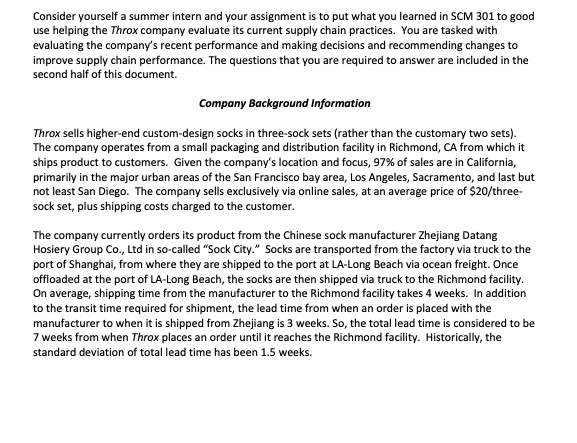
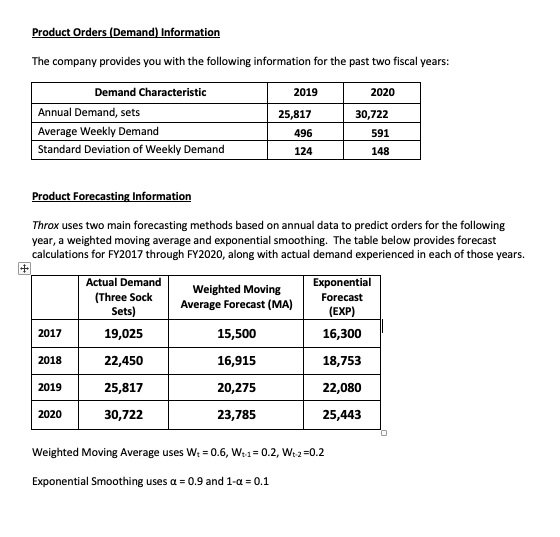
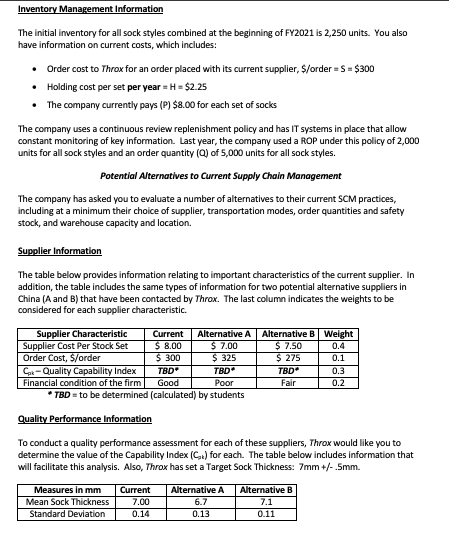

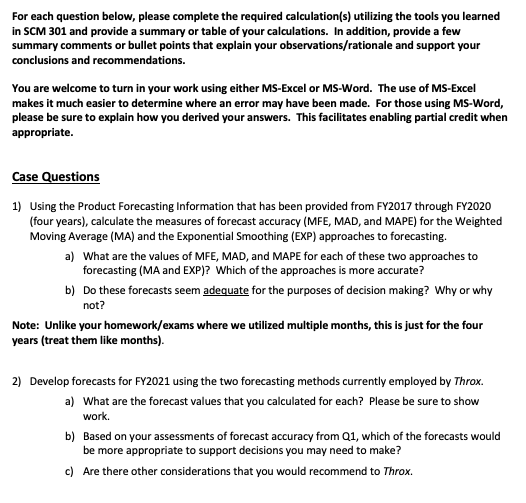
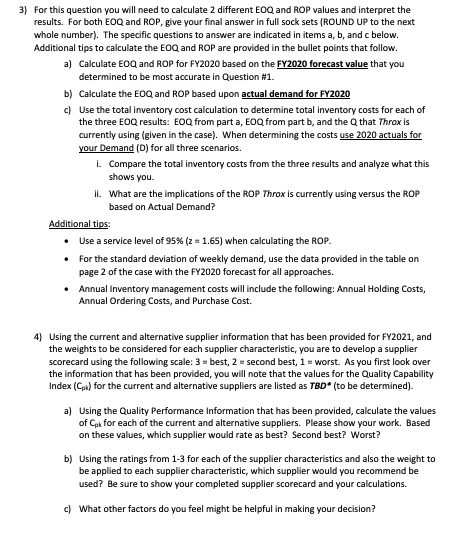
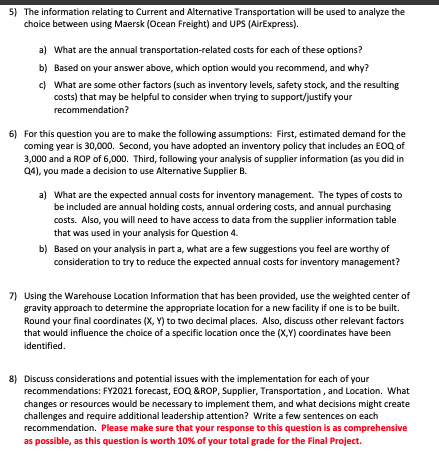 Consider yourself a summer intern and your assignment is to put what you learned in SCM 301 to good use helping the Throx company evaluate its current supply chain practices. You are tasked with evaluating the company's recent performance and making decisions and recommending changes to improve supply chain performance. The questions that you are required to answer are included in the second half of this document. Company Background Information Throx sells higher-end custom-design socks in three-sock sets (rather than the customary two sets). The company operates from a small packaging and distribution facility in Richmond, CA from which it ships product to customers. Given the company's location and focus, 97% of sales are in California, primarily in the major urban areas of the San Francisco bay area, Los Angeles, Sacramento, and last but not least San Diego. The company sells exclusively via online sales, at an average price of $20/ threesock set, plus shipping costs charged to the customer. The company currently orders its product from the Chinese sock manufacturer Zhejiang Datang Hosiery Group Co., Ltd in so-called "Sock City." Socks are transported from the factory via truck to the port of Shanghai, from where they are shipped to the port at LA-Long Beach via ocean freight. Once offloaded at the port of LA-Long Beach, the socks are then shipped via truck to the Richmond facility. On average, shipping time from the manufacturer to the Richmond facility takes 4 weeks. In addition to the transit time required for shipment, the lead time from when an order is placed with the manufacturer to when it is shipped from Zhejiang is 3 weeks. So, the total lead time is considered to be 7 weeks from when Throx places an order until it reaches the Richmond facility. Historically, the standard deviation of total lead time has been 1.5 weeks. Product Orders (Demand) Information The company provides you with the following information for the past two fiscal years: Product Forecasting Information Throx uses two main forecasting methods based on annual data to predict orders for the following year, a weighted moving average and exponential smoothing. The table below provides forecast calculations for FY2017 through FY2020, along with actual demand experienced in each of those years. Weighted Moving Average uses Wt=0.6,Wt1=0.2,Wt2=0.2 Exponential Smoothing uses =0.9 and 1=0.1 - Order cost to Throx for an order placed with its current supplier, $ /order =S=$300 - Holding cost per set per year =H=$2.25 - The company currently pays (P) $8.00 for each set of socks The company uses a continuous review replenishment policy and has IT systems in place that allow constant monitoring of key information. Last year, the company used a ROP under this policy of 2,000 units for all sock styles and an order quantity (Q) of 5,000 units for all sock styles. Potential Aternatives to Current Supply Chain Management The company has asked you to evaluate a number of alternatives to their current SCM practices, including at a minimum their choice of supplier, transportation modes, order quantities and safety stock, and warehouse capacity and location. Supplier Information The table below provides information relating to important characteristics of the current supplier. In addition, the table includes the same types of information for two potential alternative suppliers in China ( A and B ) that have been contacted by Throx. The last column indicates the weights to be considered for each supplier characteristic. * TBD= to be determined (calculated) by students Quality Performance Information To conduct a quality performance assessment for each of these suppliers, Throx would like you to determine the value of the Capability Index (Ckk) for each. The table below includes information that will facilitate this analysis. Also, Throx has set a Target Sock Thickness: 7mm+/.5mm. Transportation Information Similar to the changes that have been contemplated with regard to product sourcing, Throx would like to use a single-sourcing strategy for transportation. As an alternative to their current use of Maersk Ocean Freight, Throx would like to consider UPS AirExpress which would significantly reduce actual shipping time from Shanghai to Richmond. The table below provides information for evaluating a potential change of shipping from ocean to air. * No data is available about variation in transit times for air, so Throx assumes this is constant. NOTE: Ignore any current port capacity issues when making your decision/recommendation. Warehouse Location Information The company would also like to assess whether its current warehouse location is appropriate based on where customers are located. For each of the key markets served by Throx, the table below indicates recent population figures and X and Y coordinates of the market locations. Sales of Throx products in each location is roughly proportional to the size of the population. For each question below, please complete the required calculation(s) utilizing the tools you learned in SCM 301 and provide a summary or table of your calculations. In addition, provide a few summary comments or bullet points that explain your observations/rationale and support your conclusions and recommendations. You are welcome to turn in your work using either MS-Excel or MS-Word. The use of MS-Excel makes it much easier to determine where an error may have been made. For those using MS-Word, please be sure to explain how you derived your answers. This facilitates enabling partial credit when appropriate. Case Questions 1) Using the Product Forecasting Information that has been provided from FY2017 through FY2020 (four years), calculate the measures of forecast accuracy (MFE, MAD, and MAPE) for the Weighted Moving Average (MA) and the Exponential Smoothing (EXP) approaches to forecasting. a) What are the values of MFE, MAD, and MAPE for each of these two approaches to forecasting (MA and EXP)? Which of the approaches is more accurate? b) Do these forecasts seem adequate for the purposes of decision making? Why or why not? Note: Unlike your homework/exams where we utilized multiple months, this is just for the four years (treat them like months). 2) Develop forecasts for FY2021 using the two forecasting methods currently employed by Throx. a) What are the forecast values that you calculated for each? Please be sure to show work. b) Based on your assessments of forecast accuracy from Q1, which of the forecasts would be more appropriate to support decisions you may need to make? c) Are there other considerations that you would recommend to Throx. whole number). The specific questions to answer are indicated in items a, b, and c below. Additional tips to calculate the EOQ and ROP are provided in the bullet points that follow. a) Calculate EOQ and ROP for FY2020 based on the FY2020 forecast value that you determined to be most accurate in Question 1. b) Calculate the EOQ and ROP based upon actual demand for FY2020 c) Use the total inventory cost calculation to determine total inventory costs for each of the three EOQ results: EOQ from part a, EOQ from part b, and the Q that Throx is currently using (given in the case). When determining the costs use 2020 actuals for your Demand (D) for all three scenarios. i. Compare the total inventory costs from the three results and analyze what this shows you. ii. What are the implications of the ROP Throx is currently using versus the ROP based on Actual Demand? Additional tips: - Use a service level of 95%(z=1.65) when calculating the ROP. - For the standard deviation of weekly demand, use the data provided in the table on page 2 of the case with the FY2020 forecast for all approaches. - Annual Inventory management costs will include the following: Annual Holding Costs, Annual Ordering Costs, and Purchase Cost. 4) Using the current and alternative supplier information that has been provided for FY2021, and the weights to be considered for each supplier characteristic, you are to develop a supplier scorecard using the following scale: 3 = best, 2 = second best, 1 = worst. As you first look over the information that has been provided, you will note that the values for the Quality Capability Index (Ck) for the current and alternative suppliers are listed as TBD (to be determined). a) Using the Quality Performance Information that has been provided, calculate the values of Ck for each of the current and alternative suppliers. Please show your work. Based on these values, which supplier would rate as best? Second best? Worst? b) Using the ratings from 1-3 for each of the supplier characteristics and also the weight to be applied to each supplier characteristic, which supplier would you recommend be used? Be sure to show your completed supplier scorecard and your calculations. c) What other factors do you feel might be helpful in making your decision? 5) The information relating to Current and Alternative Transportation will be used to analyze the choice between using Maersk (Ocean Freight) and UPS (AirExpress). a) What are the annual transportation-related costs for each of these options? b) Based on your answer above, which option would you recommend, and why? c) What are some other factors (such as inventory levels, safety stock, and the resulting costs) that may be helpful to consider when trying to support/justify your recommendation? 6) For this question you are to make the following assumptions: First, estimated demand for the coming year is 30,000 . Second, you have adopted an inventory policy that includes an EOQ of 3,000 and a ROP of 6,000. Third, following your analysis of supplier information (as you did in Q4), you made a decision to use Alternative Supplier B. a) What are the expected annual costs for inventory management. The types of costs to be included are annual holding costs, annual ordering costs, and annual purchasing costs. Also, you will need to have access to data from the supplier information table that was used in your analysis for Question 4. b) Based on your analysis in part a, what are a few suggestions you feel are worthy of consideration to try to reduce the expected annual costs for inventory management? 7) Using the Warehouse Location Information that has been provided, use the weighted center of gravity approach to determine the appropriate location for a new facility if one is to be built. Round your final coordinates (X,Y) to two decimal places. Also, discuss other relevant factors that would influence the choice of a specific location once the (X,Y) coordinates have been identified. 8) Discuss considerations and potential issues with the implementation for each of your recommendations: FY2021 forecast, EOQ \&ROP, Supplier, Transportation, and Location. What changes or resources would be necessary to implement them, and what decisions might create challenges and require additional leadership attention? Write a few sentences on each recommendation. Please make sure that your response to this question is as comprehensive as possible, as this question is worth 10% of your total grade for the Final Project
Consider yourself a summer intern and your assignment is to put what you learned in SCM 301 to good use helping the Throx company evaluate its current supply chain practices. You are tasked with evaluating the company's recent performance and making decisions and recommending changes to improve supply chain performance. The questions that you are required to answer are included in the second half of this document. Company Background Information Throx sells higher-end custom-design socks in three-sock sets (rather than the customary two sets). The company operates from a small packaging and distribution facility in Richmond, CA from which it ships product to customers. Given the company's location and focus, 97% of sales are in California, primarily in the major urban areas of the San Francisco bay area, Los Angeles, Sacramento, and last but not least San Diego. The company sells exclusively via online sales, at an average price of $20/ threesock set, plus shipping costs charged to the customer. The company currently orders its product from the Chinese sock manufacturer Zhejiang Datang Hosiery Group Co., Ltd in so-called "Sock City." Socks are transported from the factory via truck to the port of Shanghai, from where they are shipped to the port at LA-Long Beach via ocean freight. Once offloaded at the port of LA-Long Beach, the socks are then shipped via truck to the Richmond facility. On average, shipping time from the manufacturer to the Richmond facility takes 4 weeks. In addition to the transit time required for shipment, the lead time from when an order is placed with the manufacturer to when it is shipped from Zhejiang is 3 weeks. So, the total lead time is considered to be 7 weeks from when Throx places an order until it reaches the Richmond facility. Historically, the standard deviation of total lead time has been 1.5 weeks. Product Orders (Demand) Information The company provides you with the following information for the past two fiscal years: Product Forecasting Information Throx uses two main forecasting methods based on annual data to predict orders for the following year, a weighted moving average and exponential smoothing. The table below provides forecast calculations for FY2017 through FY2020, along with actual demand experienced in each of those years. Weighted Moving Average uses Wt=0.6,Wt1=0.2,Wt2=0.2 Exponential Smoothing uses =0.9 and 1=0.1 - Order cost to Throx for an order placed with its current supplier, $ /order =S=$300 - Holding cost per set per year =H=$2.25 - The company currently pays (P) $8.00 for each set of socks The company uses a continuous review replenishment policy and has IT systems in place that allow constant monitoring of key information. Last year, the company used a ROP under this policy of 2,000 units for all sock styles and an order quantity (Q) of 5,000 units for all sock styles. Potential Aternatives to Current Supply Chain Management The company has asked you to evaluate a number of alternatives to their current SCM practices, including at a minimum their choice of supplier, transportation modes, order quantities and safety stock, and warehouse capacity and location. Supplier Information The table below provides information relating to important characteristics of the current supplier. In addition, the table includes the same types of information for two potential alternative suppliers in China ( A and B ) that have been contacted by Throx. The last column indicates the weights to be considered for each supplier characteristic. * TBD= to be determined (calculated) by students Quality Performance Information To conduct a quality performance assessment for each of these suppliers, Throx would like you to determine the value of the Capability Index (Ckk) for each. The table below includes information that will facilitate this analysis. Also, Throx has set a Target Sock Thickness: 7mm+/.5mm. Transportation Information Similar to the changes that have been contemplated with regard to product sourcing, Throx would like to use a single-sourcing strategy for transportation. As an alternative to their current use of Maersk Ocean Freight, Throx would like to consider UPS AirExpress which would significantly reduce actual shipping time from Shanghai to Richmond. The table below provides information for evaluating a potential change of shipping from ocean to air. * No data is available about variation in transit times for air, so Throx assumes this is constant. NOTE: Ignore any current port capacity issues when making your decision/recommendation. Warehouse Location Information The company would also like to assess whether its current warehouse location is appropriate based on where customers are located. For each of the key markets served by Throx, the table below indicates recent population figures and X and Y coordinates of the market locations. Sales of Throx products in each location is roughly proportional to the size of the population. For each question below, please complete the required calculation(s) utilizing the tools you learned in SCM 301 and provide a summary or table of your calculations. In addition, provide a few summary comments or bullet points that explain your observations/rationale and support your conclusions and recommendations. You are welcome to turn in your work using either MS-Excel or MS-Word. The use of MS-Excel makes it much easier to determine where an error may have been made. For those using MS-Word, please be sure to explain how you derived your answers. This facilitates enabling partial credit when appropriate. Case Questions 1) Using the Product Forecasting Information that has been provided from FY2017 through FY2020 (four years), calculate the measures of forecast accuracy (MFE, MAD, and MAPE) for the Weighted Moving Average (MA) and the Exponential Smoothing (EXP) approaches to forecasting. a) What are the values of MFE, MAD, and MAPE for each of these two approaches to forecasting (MA and EXP)? Which of the approaches is more accurate? b) Do these forecasts seem adequate for the purposes of decision making? Why or why not? Note: Unlike your homework/exams where we utilized multiple months, this is just for the four years (treat them like months). 2) Develop forecasts for FY2021 using the two forecasting methods currently employed by Throx. a) What are the forecast values that you calculated for each? Please be sure to show work. b) Based on your assessments of forecast accuracy from Q1, which of the forecasts would be more appropriate to support decisions you may need to make? c) Are there other considerations that you would recommend to Throx. whole number). The specific questions to answer are indicated in items a, b, and c below. Additional tips to calculate the EOQ and ROP are provided in the bullet points that follow. a) Calculate EOQ and ROP for FY2020 based on the FY2020 forecast value that you determined to be most accurate in Question 1. b) Calculate the EOQ and ROP based upon actual demand for FY2020 c) Use the total inventory cost calculation to determine total inventory costs for each of the three EOQ results: EOQ from part a, EOQ from part b, and the Q that Throx is currently using (given in the case). When determining the costs use 2020 actuals for your Demand (D) for all three scenarios. i. Compare the total inventory costs from the three results and analyze what this shows you. ii. What are the implications of the ROP Throx is currently using versus the ROP based on Actual Demand? Additional tips: - Use a service level of 95%(z=1.65) when calculating the ROP. - For the standard deviation of weekly demand, use the data provided in the table on page 2 of the case with the FY2020 forecast for all approaches. - Annual Inventory management costs will include the following: Annual Holding Costs, Annual Ordering Costs, and Purchase Cost. 4) Using the current and alternative supplier information that has been provided for FY2021, and the weights to be considered for each supplier characteristic, you are to develop a supplier scorecard using the following scale: 3 = best, 2 = second best, 1 = worst. As you first look over the information that has been provided, you will note that the values for the Quality Capability Index (Ck) for the current and alternative suppliers are listed as TBD (to be determined). a) Using the Quality Performance Information that has been provided, calculate the values of Ck for each of the current and alternative suppliers. Please show your work. Based on these values, which supplier would rate as best? Second best? Worst? b) Using the ratings from 1-3 for each of the supplier characteristics and also the weight to be applied to each supplier characteristic, which supplier would you recommend be used? Be sure to show your completed supplier scorecard and your calculations. c) What other factors do you feel might be helpful in making your decision? 5) The information relating to Current and Alternative Transportation will be used to analyze the choice between using Maersk (Ocean Freight) and UPS (AirExpress). a) What are the annual transportation-related costs for each of these options? b) Based on your answer above, which option would you recommend, and why? c) What are some other factors (such as inventory levels, safety stock, and the resulting costs) that may be helpful to consider when trying to support/justify your recommendation? 6) For this question you are to make the following assumptions: First, estimated demand for the coming year is 30,000 . Second, you have adopted an inventory policy that includes an EOQ of 3,000 and a ROP of 6,000. Third, following your analysis of supplier information (as you did in Q4), you made a decision to use Alternative Supplier B. a) What are the expected annual costs for inventory management. The types of costs to be included are annual holding costs, annual ordering costs, and annual purchasing costs. Also, you will need to have access to data from the supplier information table that was used in your analysis for Question 4. b) Based on your analysis in part a, what are a few suggestions you feel are worthy of consideration to try to reduce the expected annual costs for inventory management? 7) Using the Warehouse Location Information that has been provided, use the weighted center of gravity approach to determine the appropriate location for a new facility if one is to be built. Round your final coordinates (X,Y) to two decimal places. Also, discuss other relevant factors that would influence the choice of a specific location once the (X,Y) coordinates have been identified. 8) Discuss considerations and potential issues with the implementation for each of your recommendations: FY2021 forecast, EOQ \&ROP, Supplier, Transportation, and Location. What changes or resources would be necessary to implement them, and what decisions might create challenges and require additional leadership attention? Write a few sentences on each recommendation. Please make sure that your response to this question is as comprehensive as possible, as this question is worth 10% of your total grade for the Final Project Step by Step Solution
There are 3 Steps involved in it
Step: 1

Get Instant Access to Expert-Tailored Solutions
See step-by-step solutions with expert insights and AI powered tools for academic success
Step: 2

Step: 3

Ace Your Homework with AI
Get the answers you need in no time with our AI-driven, step-by-step assistance
Get Started


